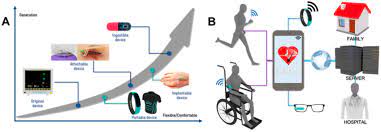I. Introduction
The intersection of technology and healthcare has given rise to the evolution of wearable health tech, transforming how individuals monitor and manage their well-being. This article explores the journey of wearable health technology, from its humble beginnings to the cutting-edge innovations that are shaping the future of personalized healthcare.
II. The Early Days: Fitness Trackers and Step Counters
The inception of wearable health tech can be traced back to simple fitness trackers and step counters. These early devices focused on monitoring physical activity, providing users with insights into their daily steps, distance traveled, and calorie expenditure. While basic, they laid the foundation for the more sophisticated health wearables we see today.
III. Expansion into Vital Sign Monitoring
As technology advanced, so did the capabilities of wearable health devices. The integration of sensors allowed for the monitoring of vital signs, such as heart rate and sleep patterns. Wearables became more than fitness tools; they evolved into personal health companions, offering users continuous insights into their physiological metrics.
IV. Smartwatches: The Convergence of Style and Functionality
The introduction of smartwatches marked a significant milestone in the evolution of wearable health tech. These devices not only displayed the time but also incorporated fitness tracking, heart rate monitoring, and notifications. Smartwatches seamlessly blended style with functionality, appealing to a broader audience and encouraging widespread adoption.
V. ECG and Blood Pressure Monitoring
Advancements in sensor technology enabled wearables to delve deeper into health monitoring. Some smartwatches now feature electrocardiogram (ECG) capabilities, allowing users to assess their heart’s electrical activity. Blood pressure monitoring also became a reality, providing individuals with valuable information about their cardiovascular health directly from their wrist.
VI. Continuous Glucose Monitoring for Diabetics
For individuals with diabetes, wearable health tech took a leap forward with the introduction of continuous glucose monitoring (CGM) devices. These wearables track blood glucose levels in real-time, offering a proactive approach to diabetes management. The ability to receive alerts and insights empowers individuals to make informed decisions about their diet and insulin dosage.
VII. Remote Patient Monitoring and Telehealth Integration
Wearable health tech has transcended personal use and entered the realm of healthcare providers. Remote patient monitoring solutions utilize wearables to collect real-time data from patients, enabling healthcare professionals to monitor chronic conditions and intervene promptly. The integration of wearables with telehealth services has further expanded access to healthcare, especially in remote or underserved areas.
VIII. Advanced Biometric Measurements and AI Integration
Recent advancements have brought about wearables capable of advanced biometric measurements. Some devices can measure parameters like oxygen saturation, skin temperature, and even assess stress levels. Artificial Intelligence (AI) algorithms enhance the interpretation of this data, providing users with actionable insights and a more comprehensive understanding of their health.
IX. Wearables in Mental Health Support
The evolution of wearable health tech extends beyond physical health to mental well-being. Some wearables incorporate features for stress tracking, mindfulness exercises, and sleep analysis to support users in managing their mental health. These features contribute to a holistic approach to well-being, recognizing the interconnectedness of physical and mental health.
X. Future Trends: Wearables in Precision Medicine and Disease Prediction
Looking ahead, wearables are poised to play a pivotal role in precision medicine. The ability to gather continuous, personalized health data allows for more tailored healthcare interventions. Wearables may also contribute to disease prediction by detecting subtle changes in biometric patterns, enabling early diagnosis and proactive management.
XI. Overcoming Challenges: Data Security and User Privacy
As wearables become more integral to healthcare, addressing challenges related to data security and user privacy is paramount. This section explores the measures taken by manufacturers and healthcare providers to ensure the secure storage and transmission of sensitive health data, maintaining the trust of users in wearable health tech.
XII. The Role of Wearables in Public Health Initiatives
Wearable health tech is not only individual-centric but also has the potential to contribute to broader public health initiatives. This section discusses how aggregated and anonymized data from wearables can aid in tracking and managing the spread of infectious diseases, responding to health crises, and informing public health policies.
XIII. Conclusion
The evolution of wearable health tech reflects a journey from basic step counters to sophisticated health companions. From fitness trackers and smartwatches to advanced biometric measurements and mental health support, wearables have become integral to personal health management. As technology continues to advance, wearables are poised to play a pivotal role in the future of precision medicine and proactive healthcare, empowering individuals to take charge of their well-being.
FAQs
- What were the early days of wearable health tech focused on? The early days of wearable health tech were focused on basic fitness trackers and step counters, primarily monitoring physical activity and providing users with insights into their daily steps, distance traveled, and calorie expenditure.
- How did smartwatches contribute to the evolution of wearable health tech? Smartwatches marked a significant milestone by seamlessly blending style with functionality. They incorporated features such as fitness tracking, heart rate monitoring, and notifications, appealing to a broader audience and encouraging widespread adoption of wearable health tech.
- What advanced capabilities were introduced in wearable health tech for individuals with diabetes? For individuals with diabetes, wearable health tech advanced with the introduction of continuous glucose monitoring (CGM) devices. These wearables track blood glucose levels in real-time, providing a proactive approach to diabetes management.
- How have wearables contributed to mental health support? Wearables now contribute to mental health support by incorporating features for stress tracking, mindfulness exercises, and sleep analysis. These features recognize the interconnectedness of physical and mental health, promoting a holistic approach to well-being.
- What is the future role of wearables in healthcare, according to the article? The article suggests that wearables are poised to play a pivotal role in precision medicine, contributing to more tailored healthcare interventions. They may also aid in disease prediction by detecting subtle changes in biometric patterns, enabling early diagnosis and proactive management.

